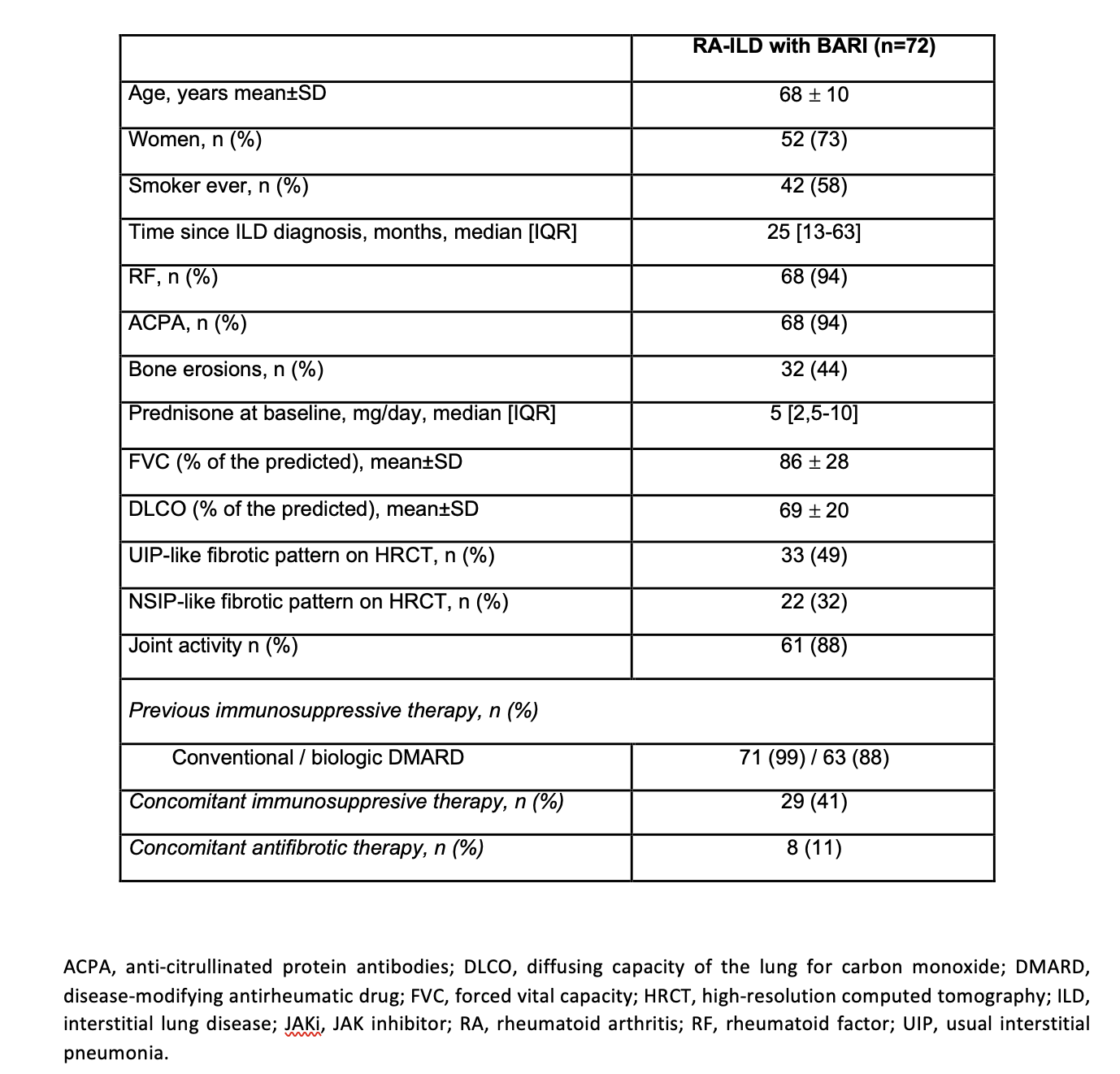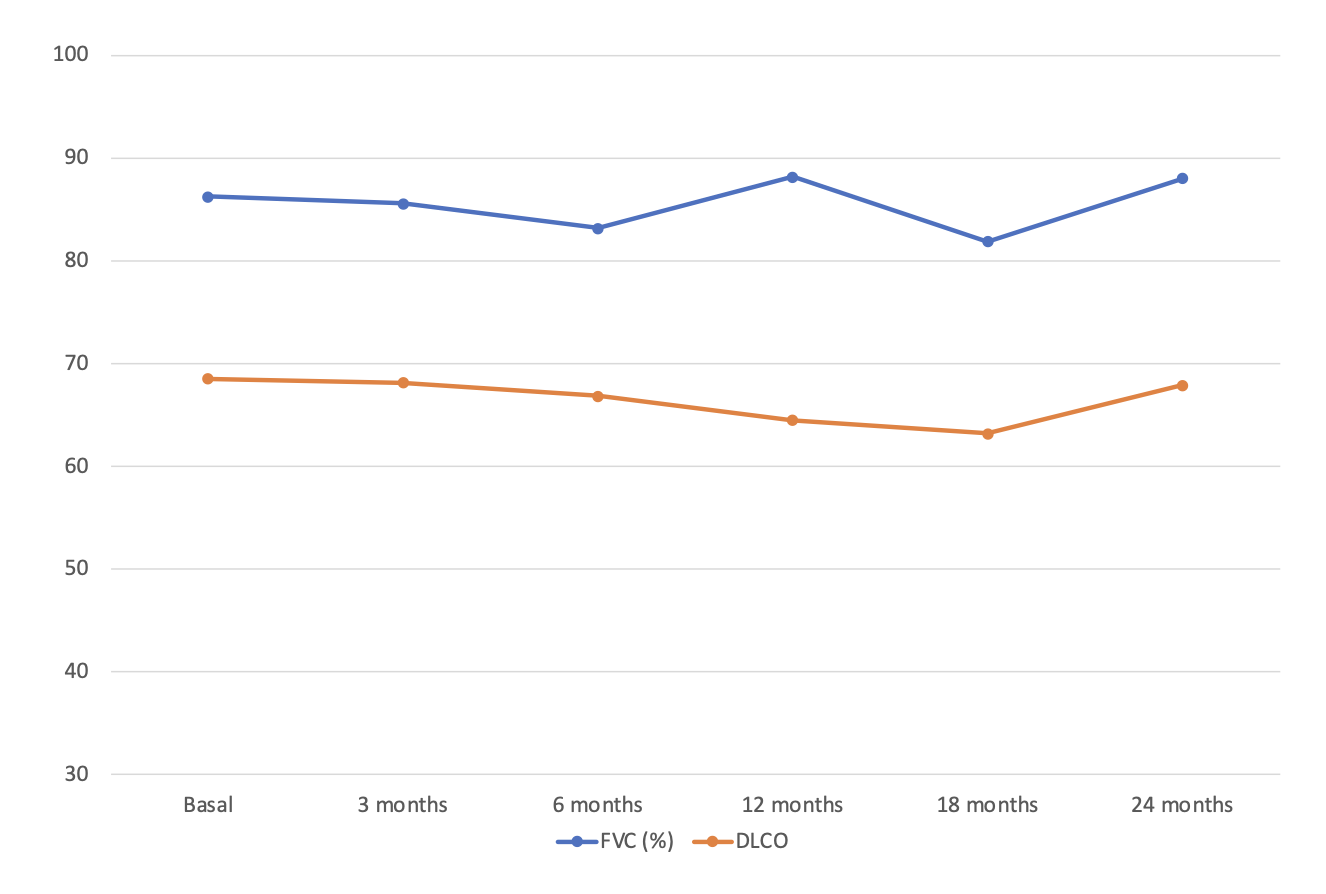Session Information
Session Type: Poster Session A
Session Time: 10:30AM-12:30PM
Background/Purpose: Interstitial lung disease (ILD) is a severe extraarticular manifestation of rheumatoid arthritis (RA) that determines a worse prognosis, leading the cause of mortality in RA patients, second only to cardiovascular disease. Abatacept and rituximab are the recommended drugs. JAK inhibitors (JAKi) have demonstrated efficacy in RA. The JAKi approved by the Food and Drugs Administration (FDA) and the European Medicines Agency (EMA) for the treatment of RA are tofacitinib (TOFA), baricitinib (BARI), upadacitinib and filgotinib. The evidence on efficacy of BARI in RA-ILD is growing. Our objective is to assess a) the effectiveness and b) the safety of BARI in AR-ILD patients.
Methods: National multicenter study of 72 RA-ILD patients on treatment with BARI. We analyzed the following outcomes from baseline:
a)
forced vital capacity (FVC)
,
b)
diffusing capacity of the lungs for carbon monoxide
(DLCO),
c)
chest
high resolution computed tomography (HRCT), d)
dyspnea (modified Medical Research Council scale), e) arthritis activity (DAS28-ESR or clinical records), and f) sparing corticosteroids effect.
Results: We studied 72 patients (52 women / 20 men; mean age 68
±
10 years) from clinical practice on treatment with BARI. Baseline demographic and clinical characteristics are shown in Table.
All
patients had received disease-modifying antirheumatic drugs (DMARDs) before BARI [Methotrexate (62; 86%), Leflunomide (51; 70%), Sulfasalazine (19; 26%), Abatacept (45; 63%), Tocilizumab (25; 35%), Adalimumab (22; 31%) and Rituximab (17; 24%)]. Median [IQR] ILD duration up to BARI initiation was of
25 [13-63]
months.
Mean baseline values of FVC and DLCO (% predicted) were 86
±
28
and 69
±
20, respectively. Patients were followed-up for a median [IQR] of 14 [6-42] months. The evolution of FVC and DLCO remained stable during the first 24 months (Figure). At the end of the follow-up, available chest HRCT images improved/ stabilized
in 72% of patients. Stabilization or improvement of dyspnea was found in 90% of patients. Most patients showed articular remission or low activity. BARI was withdrawn in 32 (46%) patients due to articular inefficacy (n=22), lung inefficacy (n=5), development of hypersensitivity pneumonitis (n=1), ocular involvement (n=1), acute myocardial infarction (n=1), respiratory infection (n=1) and appearance of brain cancer (n=1).
Conclusion: BARI might be safe and useful in controlling both pulmonary and joint disease in RA-ILD patients.
Figure. Evolution of pulmonary function tests (mean % of the predicted FVC and DLCO) in RA-ILD patients with BARI therapy at baseline and 24 months.
To cite this abstract in AMA style:
Serrano-Combarro A, Atienza-Mateo B, Valero Jaimes J, Pastor-Mena M, Melero-Gonzalez R, Martín López M, Castañeda S, Loarce J, Egües Dubuc C, Mena Vázquez N, Carrasco-Cubero C, Perez-Garcia C, Blanco Madrigal J, Vegas Revenga N, Pérez Albadalejo L, Ortega-Castro R, Palma D, Fernández-Ortiz A, López Lasanta M, Garijo Bufort M, Casafont-Sole I, García-Valle A, Martinez-Vidal M, Flores Robles B, CERVANTES PEREZ E, Brana Abascal I, Rojas Herrera S, Sarmiento-Monroy J, Ruiz-Esquide V, LAMUA RIAZUELO J, Astigarraga-Urquia U, Ferrer D, Blanco-Alonso R. Baricitinib in Rheumatoid Arthritis – Interstitial Lung Disease. National Multicenter Study of 72 Patients [abstract]. Arthritis Rheumatol. 2024; 76 (suppl 9). https://acrabstracts.org/abstract/baricitinib-in-rheumatoid-arthritis-interstitial-lung-disease-national-multicenter-study-of-72-patients/. Accessed .« Back to ACR Convergence 2024
ACR Meeting Abstracts - https://acrabstracts.org/abstract/baricitinib-in-rheumatoid-arthritis-interstitial-lung-disease-national-multicenter-study-of-72-patients/


